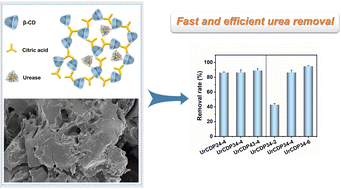Cyclodextrin polymer-confined urease for the fast and efficient removal of urea†
Abstract
Urease is a nickel-containing oligomer that can be used to catalyze the decomposition of urea. Free urease is unstable and prone to inactivation, whereas the immobilization of urease improves its resistance to environmental changes. A green and harmless cyclodextrin polymer (CDP) that has a network structure and excellent modifiability was selected for the immobilization of urease. Citric acid cross-linked CDP (CACDP) is oxidized by sodium periodate to obtain the aldehyde-functionalized dialdehyde CDP (DACDP). Urease is covalently bound to the CDP through a Schiff base reaction between the amino groups and aldehyde groups on DACDP to obtain urease-immobilized CDP (UrCDP). A series of characterization methods and urea-removal experiments confirmed the successful immobilization of urease on the polymer and thus the good removal effect. The maximum removal capacities of UrCDP34-6, UrCDP34-4, and UrCDP34-2 for urea are 145.7 mg g−1, 242.9 mg g−1 and 291.1 mg g−1, respectively. Urea-removal experiments at different temperatures and pH values proved that UrCDP maintains its catalytic activity in response to environmental changes. At the same time, a simple continuous-flow treatment device proved that UrCDP has the clear ability to continuously remove urea. This effective urease-immobilization and urea-removal method is experimentally proven and envisions potential applications in medical and wastewater treatment.



 Please wait while we load your content...
Please wait while we load your content...